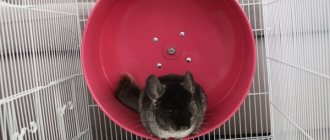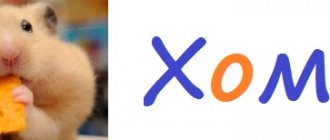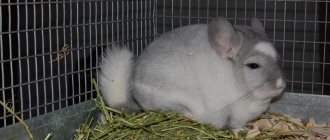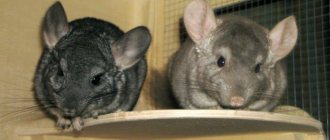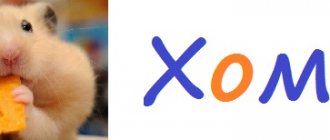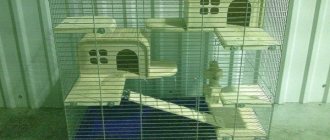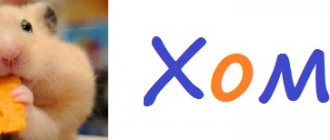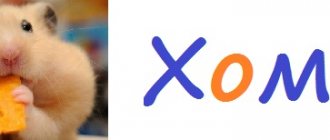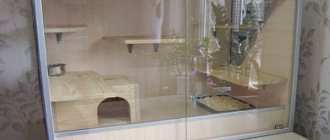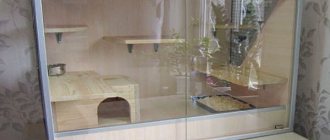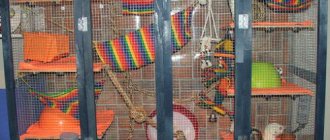- home
- Chinchilla
03/28/2019 When choosing a chinchilla as a pet, you need to be prepared for the fact that the animal is active. He will not be cheerful and healthy if he is not provided with room to move. Does a walking ball solve this problem? Is it worth resorting to this method of organizing a promenade for chinchillas? The answers to these questions are in this article.
Purchased and homemade cages
Pet stores offer two ready-made options for keeping chinchillas at home - a display case and a cage. Metal cages are the most common type of housing for rodents and have the following advantages:
- safety;
- Possibility to equip with additional accessories;
- ease of cleaning and disinfection;
- compactness and ease of transportation;
- durability and strength.
Chinchilla cage
Another option for a purchased cage for keeping chinchillas at home is a display case. It is spacious; usually the choice in favor of a display case is made if you want to start breeding rodents. This type of housing is a wooden frame surrounded by glass walls. Externally, the showcase resembles a spacious aquarium with several floors.
The main negative side of the display case design is the ability of the wooden frame to absorb odors and swell over time from excess moisture. Not so long ago, options for display cases with aluminum profiles appeared in pet stores, albeit at a high cost.
An alternative to purchased cages and display cases can be homemade housing for your chinchilla. The design of the future home may be different, the main thing is that the following requirements are met:
- availability of light;
- safety;
- strength;
- good ventilation.
Cage for a chinchilla The cost of a homemade cage will be significantly lower than a purchased one, and you can furnish it to your liking.
Do-it-yourself housing for a chinchilla
Often breeders decide to make a chinchilla cage with their own hands.
If you have a desire to tinker, then here are a few instructions to help you. First, buy the necessary materials for the job. It is better to give preference to wood. The frame will be made of bars, lining, boards and many shelves. Chipboard or plywood are also suitable. To close the holes, you need a metal mesh.
The following tools will be useful:
- hacksaw;
- jigsaw;
- hammer;
- drill and wood bits;
- stationery knife, marker;
- metal scissors;
- ruler.
To begin, prepare a drawing, taking into account the size of your room and the size of the desired pet house. Then start making the base, which needs to be covered with clapboard.
Next, the cage frame is built from the bars.
The bars are attached to the corners of the base using self-tapping screws or nails.
Using a metal mesh, the walls of the cage and its roof are tightened.
To make cleaning easier, we recommend making several doors on different sides.
Then you can install various shelves and place the accessories your animal needs on them.
It is best to cover the back of the cage with a sheet of plywood.
Finally, it is necessary to treat the house with a protective impregnation.
If you show your imagination, you can use old furniture and other available materials. An old cabinet is often used:
- The doors are removed from the furniture and the inside is repurposed for animals. Some of the shelves are cut out to allow animals to move freely.
- You need to cut a hole in the top of the closet and stretch the mesh so that the house is ventilated.
- In place of the cabinet doors, you can make frames from wood and tighten them with a metal mesh.
A do-it-yourself chinchilla display “from scratch” will require a little more time and skill.
So, you will need:
- metal tubes for the frame, or wooden yards;
- corners to connect parts;
- cogs;
- metal mesh;
- door hinges.
Then follow the instructions step by step:
| Step | Description |
| 1. | First you need to prepare drawings, taking into account the minimum acceptable dimensions for a chinchilla cage. |
| 2. | Next, we assemble the frame from pipes and yards, using corners for reliability, and fasten them with screws. |
| 3. | Make (internal) markings, designating areas for the animal’s life, that is, think about a place for sleeping, playing, toilet, bath, etc. |
| 4. | The mesh bottom is attached to the cage frame. For this you need a welding machine. |
| 5. | Connect the frame and walls of the house. |
| 6. | Next you need to install the door, use hinges and a lock. |
| 7. | Attach accessories inside the house. |
A do-it-yourself corner display case for a chinchilla is quite popular, because it can significantly save space in your apartment. To make one, show a little imagination and dexterity, and the result will definitely please you!
Where to place a chinchilla cage
Take seriously the choice of place in the apartment where the cage with the animal will be placed. It is better not to change the location of the cage throughout the animal’s life.
Here are some tips for you:
- the room should be dry and light;
- direct rays of the sun should not enter the cage;
- drafts should not be allowed;
- the air temperature where the animal lives should not exceed +23° C.
- the cage should not be placed next to electrical heating appliances;
- It is not advisable to place the cage on the floor;
- the cage should not be placed next to loud devices (equipment);
- Since chinchillas are very active at night, you should not place the cage in the bedroom. It's better to put it in the living room.
Cleaning a chinchilla's cage or display case
It is not enough to simply make a house, choose a place for it and move your pet into it; you must also not forget about caring for your pet’s home. Once a week you need to do a general cleaning, and at this time the animal should be placed in a carrier. The house can be wiped with a wet cloth and even vacuumed. At the end of cleaning, you need to wipe the cage dry. Disinfection (if necessary) is carried out using specialized products purchased at a pet store.
Rodent Health Benefits
The ball will be convenient for the owners and useful for the pet.
Advantages of the accessory
The device has a number of advantages:
- Ensures the safety of the hamster. The owners will not step on it, cats or dogs will not attack it. The rodent will not get lost or run away even in the absence of constant supervision.
- Protection for home furniture. The animal will not be able to chew tables, chairs, sofas once outside the cage.
- Allow pets to roam around the apartment. Some hamster owners walk their pets in balls in their summer cottages and gardens.
- Suitable for carrying while going to the veterinarian. Can be used as a temporary house when the owners clean the cage.
- Allows you to keep your home clean. The ball itself is easy to wash, so the owners will not have any difficulty removing feces.
- Benefit for health. Jogging in a ball strengthens muscles and is suitable as physical activity for a rodent.
- Convenience for owners. After walks, the animal gets tired, after which it sleeps peacefully at night, without disturbing its owners.
The device ensures the safety of the hamster.
Disadvantages of a walking ball
The products have a number of disadvantages:
- Short service life. Plastic balls become unusable after just a year. Frequent use will cause the door latches to wear out faster.
- Low duration of use. You should not leave your pet inside for more than 20 minutes. If the hamster sits in the ball longer, its condition will worsen due to overheating and limited oxygen supply.
- Cover falling out in homemade structures. If the door opens, the pet may escape.
How to make a bathing suit for a chinchilla with your own hands
You can make a bath for your pet yourself. It's not as difficult as it might seem at first glance.
Tools and materials
To do this, you need to set aside some free time and prepare everything you need:
- a plastic water bottle or a food-grade plastic canister with a volume of at least five liters;
- sharp knife;
- lighter;
- wire.
Manufacturing process
- In the side wall of the bottle or canister, you need to cut a circle of such a diameter that the pet can enter the container without much difficulty.
- Carefully melt the edges of the cutout with a lighter so that the animal does not get scratched.
- Secure the bath securely with wire so that it does not tip over when the rodent takes hygienic baths.
This design is not suitable for permanent placement in a cage, because the animal may chew the plastic. But for a half-hour swim it’s good. If the canister is transparent, this will allow everyone to watch the actions of the pet with interest.
Teaching a hamster to ride
You bought your home a new exercise machine, but this does not mean that he will immediately understand what to do with it. You will have to spend several days training your pet to use this toy. To make the process go smoothly, remember a few tips:
- choose a time when the fluffy has slept, had dinner and is ready to play;
- put the toy in the cage, opening all the entrances, and let the animal get to know it;
- when the homa goes inside, close the lids (they must be inserted into the entry holes and turned clockwise);
- check whether the doors are closed: it is better to double-check a couple of times than to later catch a tiny creature throughout the apartment;
- now take out the ball along with the animal and place it on the floor;
- when the rodent gets used to it, it will begin to move its paws, and the ball will roll;
- The first lesson should not exceed 5 minutes; you need to put the simulator back in the cage and open the doors.
Classes in the first week should not last longer than 5-10 minutes. When the fluffy gets used to the new toy, the walking time can be increased to 20 minutes a day, but it should not be more than half an hour. After all, excessive physical stress is very harmful for tiny creatures.
When walking, remove dogs and cats from the room. Even if your other animals are quite peaceful towards rodents, they can still scare a cute animal with their sight and smell. Do not leave the homa in the ball alone for a long time. What if at exactly this moment the door of the toy breaks and the rodent escapes?
After completing the walk, the toy must be washed and dried. The floor in the room where the animal was rolling around will have to be swept or washed, because during the walk the pet could have lost reserves from its cheek pouches, peed itself, or had a bowel movement.
As practice shows, after purchasing a walking ball for a hamster, the animal begins to behave calmer at night, as it loses a lot of energy during “excursions.” Don’t forget to pamper your furry pet after such walks with a piece of his favorite treat, especially during training.
Which material is better?
Pet stores provide different types of bathing containers that are made from a variety of materials. Each of them has its own advantages. But there are also some disadvantages.
Glass
A good choice is a glass bathing suit. It is usually made of durable glass in the form of a round aquarium. The chinchilla is not interested in this material, so the animal will not try to chew it. This bathhouse is easy to wash and keep clean. It is quite heavy, and the pet will not turn the container over during the hygiene procedure. But most importantly, the transparent walls allow you to easily observe the process of bathing your pet.
Plastic
A plastic bathing container must be made of high-quality material. Then it will last a long time. It is also easy to wash and clean. The disadvantages include the fact that it is not difficult for the animal to turn it over during the active procedure. Therefore, you should think about where to put the bathing suit to prevent this from happening. The pet can also chew the walls and swallow plastic pieces. Pet stores offer convenient plastic baths with a removable lid with a hole for entry. Their price is low.
Ceramic
The ceramic bathtub is quite stable. It washes well and does not absorb foreign odors. The main disadvantage is the opacity of the walls. You won't be able to watch your pet bathe. In this case, the animal is left to its own devices. The finished ceramic bathing suits are very decorative. They are made in the shape of a house or animal.
Wooden
A fairly popular material for swimsuits is wood. These chinchilla baths are relatively cheap and quite durable. They are made from various types of wood. It is impossible to make bathing containers from chipboard or fiberboard because of their harmful composition. Wooden bathing suits are short-lived and not particularly practical. They are difficult to clean after each procedure. Wood absorbs odors and moisture well. And the animal will definitely gnaw on such a structure.
From plywood
Plywood bathing suits are easy to complete in one day. You need to put together a box of a certain size with an open top. The front wall can be made of plexiglass or other transparent material. Then watching your pet will be a pleasure. But a plywood product has the same disadvantages as a wooden one.
Model overview
If you are not sure which hamster walking ball is suitable for your pet, study the assortment in the store and consult with the seller. There are many good balls for walking hamsters, the price range is quite wide.
Here are some of the most popular models:
- Fun Bowl. Oval ball for Syrian hamsters. Larger diameter – 19 cm. Colorless transparent plastic. The trainer has 4 doors and 20 narrow ventilation slots. Cost 760 rubles.
- Super Pet. Round balls of various colors. They have 2 entrances and many holes for air circulation. The product is certified, non-toxic. The company produces balls for hamsters of different sizes. Thus, a toy for a Dzungarian (d = 12.7 cm) costs from 300 rubles, and for a Syrian (d = 18 cm) – from 490 rubles.
- Trixie. The round hamster ball is sold with a stand. A stable base in the form of a square. The toy is intended for Syrian hamsters (d = 18 cm). The body is transparent, colorless. Has 2 doors. The cost of the set including the stand is from 380 rubles.
- Credo. A ball made of transparent orange plastic for dwarf hamsters (d = 12.5 cm). There is only 1 exit, but the ventilation windows are evenly spaced. One of the cheapest models, costs about 200 rubles.
- Savic for dzungarians and Roborovsky hamsters (d = 12 cm). 2 entrances, round and slot-shaped ventilation holes. Price – 330 rubles.
- Georplast for small breed hamsters (d = 12.5 cm). A very stylish toy, made in the shape of a globe. The stand is stable. There are 2 entrances to the ball, ventilation is excellent. Cost – from 420 rubles.
A correctly selected ball will help the animal explore the world and keep itself in good shape. But for this, the khoma needs to be taught how to use the simulator.
Why is a walking ball dangerous?
A walking ball has many disadvantages:
- In natural conditions, chinchillas do not move by moving their paws, like cats, but by jumping. This is impossible in a ball.
- The curved design of the product suggests a flexible spine and a plastic constitution. The chinchilla's skeletal system is rigid and fragile.
- Rodents react very hard to lack of fresh air and overheating. Ventilation holes do not completely solve the problem. The animal may lose consciousness.
- The plastic from which the ball is made can release toxins when heated, which is very dangerous for the rodent.
- In reality, the animal does not happily run around the apartment inside the sphere, but convulsively and panickedly tries to get out of it, receiving psychological stress.
As a result, it turns out that the ball solves the problem for the owner, and the animal suffers.
Accessory selection
Choose a walking ball based on the size of the animal. When very small, his back will arch. This is not only uncomfortable, but also extremely traumatic. In a large structure, the animal will “dangle” from side to side and will quickly get tired.
As for the ventilation holes. To ensure good air exchange they must be large. However, there is a danger that while running the foot will get stuck with all the ensuing consequences. Therefore, manufacturers are looking for a compromise solution.
Various models are available for sale. There are spheres with the help of which the animal has the ability to move in different directions. In designs with a track, the trajectory of movement is already specified.
In a transparent product, the animal has better visibility.
DIY walking ball for chinchilla
The price of such a product is usually not low, from 500 rubles and above, depending on the modification, quality, and brand. Folk craftsmen learned to make it from improvised materials.
Necessary materials
The material can be an ordinary plastic bottle. The main requirement is that it must be transparent and fit in size. Ideally, it is a rounded or oval shaped bottle.
Manufacturing process
The bottle is screwed on with a cap. Using a hot rod, holes are cut in the walls. Remove burrs with sandpaper. There is an entrance hatch at the bottom. To do this, the bottom must not be cut all the way around. Instead of a latch, you can use a small piece of tape or tape.
You need to use a homemade device carefully. A chinchilla is not a toy, but a living creature
You can only establish contact with a pet when you treat it with care and love.
Saving and saving your refrigerator
Summer, as everyone has noticed, has become very hot. From 30 degrees and above. I noticed how long the refrigerator runs. And it wastes a lot of energy. I did this by blowing the radiator. The idea came from memory from the magazine “Young Technician”.
The motors operate under the control of such a temperature relay. It allows you to set the boundaries of the relay operation. I chose the relay based on economy.
This is how I mounted the measuring sensor.
Power supply from such a 12 volt unit.
Even according to the most moderate estimates, such a device reduces the operating time of the compressor by 15 percent. Accordingly, there is less wear on the compressor and energy costs.
True, you need free space to place the fan.
There are relays with a ready-made housing.
When installing the relay, it can be configured (for perfectionists): one point is taken in water with ice (0 degrees), the second in a boiling kettle (100 degrees).
Fans: 120 mm in diameter, 2 pieces or more. Less - there will be no air flow.
Based on selection, I chose 36 degrees as the switching point.
There are such devices on 2 refrigerators.
In summer, when the temperature is 30 degrees and above, the refrigerator does not work around the clock.
Criteria for choosing a ball for a walk
A high-quality and correctly selected walking ball will ensure the comfort and safety of the animal.
Let's figure out what criteria you need to pay attention to
What sizes are there and which one is better to choose?
A ball of the correct size will protect your pet from possible injury
The angle of the pet’s back depends on this, which is important for its health. Hamster balls come in the following diameters:
- 12-13 cm – model for small rodents, such as dwarfs;
- 18 cm – suitable for a Syrian hamster;
- 28-33 cm - a ball for a large rodent, for example a common hamster.
In a small sphere, the spine will bend strongly inward. For a one-time walk this is not critical. Constant use will harm your pet. If the ball is too big for the hamster, the baby will “wiggle” from side to side, which can lead to stress and damage to his limbs.
Is color important?
Rodents see the world around them differently than we do. Their eyes allow them to distinguish only the outlines of objects. In most cases, when moving, they use their sense of smell. Hamsters practically do not distinguish between colors, with the exception of yellow and green.
Is fastening necessary?
The mount is an additional accessory that allows you to attach the ball to a stand and fix it in one place. This will not allow the hamster to move freely around the house, but will still help fill the need for physical activity, acting like a running wheel.
There is no great need for this accessory, since usually the cages are already equipped with a special wheel. It is relevant if the hamster has taken a fancy to his walking ball, but is reluctant to move around in a wheel installed in a cage.
What kind of rodents run in a wheel?
Runners for rodents are used if the animal is kept in a cage that does not allow it to move a lot and quickly. Lack of activity causes obesity, muscle weakness, chronic diseases, and shortens life expectancy.
Wheels and balls for rodents allow you to reproduce natural habitat conditions. The animal instinctively understands what the device is intended for and how it is used. Often, it is enough for the owner to help the pet once.
They are used when keeping fast-moving animals - rats, hamsters, mice, and less often chinchillas. The rabbit wheel is not used - this animal does not run, but jumps.
Making a spinning wheel for a rodent with your own hands
If you are an avid chinchilla lover, and all the running wheels available for sale do not suit you, then we suggest that you make your own sports equipment. So you can calculate the necessary dimensions yourself, suitable for the size of your pet, and select the material. The easiest way to make a wheel is from wood, as this is the most affordable and easy-to-handle material.
Video - DIY wheel for chinchillas
Tools required for work:
- plywood sheet;
- compass, ruler;
- screws;
- bolts;
- jigsaw for cutting a circle;
- planks 1-2 centimeters wide and up to 17 centimeters long;
- drill.
Step-by-step instructions for making a plywood wheel
Step one. We cut a hole in the center of the plywood sheet using a jigsaw. This will be the center of the future wheel. Using a compass, we measure the required wheel diameter from the resulting hole. Chinchillas are larger than hamsters, so a standard wheel will not work for us. The minimum wheel diameter should be 32-34 centimeters, width - 15-17 centimeters.
The hole can be made after cutting out the circle
The animal should fit comfortably inside the wheel and move its paws freely, and the body should be in the lower part of the structure while running. In a wheel that is too small, the animal will “scroll”, stumble, and the back will bend too much, which can lead to health problems - dislocated limbs, spinal injuries. After you measure the circle, you need to cut it out with a jigsaw.
Step two. In the same way, cut out a ring of the same diameter - using a compass and ruler. The plywood circle and the ring must be made of the same material.
Step three. Now let's start making the running ring itself. To do this, we connect the ring and the plywood circle together with planks on which the animal will step with its paws. We attach the planks using self-tapping screws to the outside of the circle and ring. So, firstly, the structure will be much stronger, and secondly, the animal will not be able to get hurt on uneven protrusions.
Step four. Next, we construct the rotation unit and the fastening itself. We thread a 15-centimeter bolt with a diameter suitable for the hole we cut into the wheel so that its main part is on the outside of the wheel. We secure it with metal washers. We put a rubber bearing on the outside of the bolt so that the wheel slides smoothly and does not touch the cage wall while moving.
Step five. We fasten the bearing with self-tapping screws to a wooden plank, which will serve as a holder. To prevent the structure from tipping over, it is better to secure it to the wall of the cage. If this is not possible, then the board on which the wheel will be installed must be at least 15 centimeters wide, otherwise the animal will easily turn the wheel over.
Finished wheel
In a clean, voluminous wooden wheel, the animals feel comfortable and safe. And if they get tired of running, they entertain themselves by gnawing on fragrant wood. Subsequently, you can easily replace the rim with a new one, for example a metal one, while maintaining the frame of the previous design.
Running wheel made from a saucepan
A chinchilla trainer can be made from household utensils, for example, an aluminum pan. It is necessary to choose kitchen utensils of the right size. And since the height of the pan is too large, approximately half of the height will need to be cut down (the width of the future wheel should be 15-17 centimeters), and the edges should be sharpened with sandpaper so that the animal does not subsequently get hurt on the edges.
A useful simulator can be made from an ordinary saucepan
After this, a hole with a diameter of 0.3-0.5 centimeters is drilled in the center of the metal circle, which previously served as the bottom of the pan. A bolt is also inserted into it and the tensioner roller is placed on it. To prevent the rodent's paws from slipping on a smooth metal surface, you can install a mesh wheel inside. The toy for your chinchilla is ready.
Aluminum running wheel
Features of using balls for walking
To protect your pet, follow the rules for using walking spheres.
Security measures
Follow safety precautions to avoid harming your hamster:
- Keep track of the length of your walks. Do not let your pet run around the apartment for more than 20 minutes. Otherwise, due to a lack of oxygen, the rodent will feel unwell.
- Carefully place the animal inside. Close the door tightly. Make sure that the passage does not open, as the hamster may run away or get lost.
- Do not leave the ball on tables or shelves. A fall can lead to injury and death of the rodent. Carefully lower the sphere to the floor. Protrusions and stairs along which the ball can roll should not be accessible to the pet.
- Keep dogs, cats, and small children away from the walking area. Having become interested in a toy, they can start rolling and kicking it. As a result, the hamster will be injured.
- Do not push the sphere to speed up the rodent. Such an action will cause stress and scare the animal. The rodent must move its vehicle independently at an appropriate pace.
- Do not put several individuals in one ball. Hamsters can suffocate due to lack of oxygen. For each individual, purchase a separate toy.
- Be careful when letting your pet go for a walk. Be careful not to accidentally kick the ball. Even a slight push can become stressful for a hamster. A strong blow to the toy will cause injury to the rodent.
To avoid harming your hamster, watch his walk.
How to teach to ride
Hamsters should be accustomed to a new vehicle gradually. The first time, place the rodent inside for just 1-2 minutes. Then start increasing the duration of your walks. Monitor the animal's reaction to the innovation. If the hamster is afraid or has a negative attitude towards the ball, stop using it. Stress will only harm your pet and shorten its lifespan.
To provoke interest in the sphere, place a treat inside: a piece of apple, pear or other permitted fruit. The rodent will climb into the ball to get a treat. Once it is inside, lightly rotate the product to show the animal how the new toy works. Make all movements slowly, smoothly, avoid sudden loud sounds. Noise and threats will cause stress and reluctance to continue learning.
Please be patient. Do not rush the animal, take into account its individual characteristics. Eliminate stressors when studying. Warn children not to make noise, scare the hamster, or speak loudly until the pet gets used to the ball. Do not allow cats or dogs into the room. They look larger from the plastic container.
Seeing the head of a predator, the hamster will get scared and may completely refuse to use the toy for walking.
Sphere for a rodent - what is it?
In the wild, chinchillas move a lot, as these animals live in mountainous areas. Tamed pets are forced to stay locked up. Natural data and genetic predisposition require active movement in order to maintain the health of the animal. For this purpose, an invention such as a walking ball for a chinchilla was invented.
The product consists of two interconnected hemispheres and is made of durable translucent plastic. Additionally, there are holes for ventilation and an entrance hatch. The animal is placed inside the device and closed. He will not be able to get out without human help unless the attraction for some reason collapses. The diameter of the ball can be from 18 to 32 cm.
The main argument for using this method of walking is that the chinchilla will not be able to chew the furniture or climb into a hard-to-reach place in the apartment.
DIY walking ball for chinchilla
It’s easy to make a walking ball for chinchillas yourself. A simple plastic bottle will do. We cut it and straighten it carefully. You can take a bottle of any size, the main thing is that it fits the size of your animal. Moving in it should be comfortable.
You can make a walking ball from a 5 liter bottleA five-liter bottle works great. Close it with a lid first. The bottom needs to be cut, but not to the very end, but so that the chinchilla can crawl through. Don't forget to make small holes for air to enter. After this, move the notched bottom and let the animal inside. Watch carefully how she moves. Do not insist under any circumstances; if the animal is unhappy and in a bad mood, then release it from the homemade ball. Try again later when he is ready to experiment.
If it seems to you that the chinchilla likes the new toy and is happy to walk around the house in the ball, still do not leave it in it for a long time. Half an hour is enough for active entertainment.
A large cage will eliminate the need to walk your chinchilla in a ball
If you want to bring joy to the animal, immediately make him a large display case or cage with toys. The most luxurious gift for a pet is an equipped room for permanent residence, fenced off from other rooms with mesh or glass.
How to use such a toy?
If you decide to use a ball for a chinchilla, you need to accustom it to it gradually. It is not recommended to leave it inside for more than 3-5 minutes at first. “Training” should bring satisfaction to your pet, not fear.
If your chinchilla panics when he sees the ball, there is no need to insist. Nothing good will come of this idea. There are exceptions when the pet is interested in this idea and asks to stretch its paws.
Sometimes, to achieve mutual understanding, you need to put a treat in the sphere. When the animal eats it, you need to slowly start rotating the device. This way the pet will quickly understand what is required of him.
Children need to be explained that they cannot leave the animal in the ball for a long time. If they initiated such a walk, you need to monitor the process and make sure that the pet is removed from this attraction on time.
Construction of a cell
I highlight several reasons for building a cage with my own hands:
- Significant financial savings;
- Construction of a house for the needs of a chinchilla;
- Investing effort and warmth in keeping a chinchilla at home.
There is nothing complicated in the construction of a chinchilla cage; the diagram of the parts is simple and clear at first glance at the photo. Let’s look at the important nuances of construction that need to be taken into account for a comfortable life for animals and humans.
Place the cage frame in a vertical position. Chinchillas are active animals that love to jump. A low and wide cage will be uncomfortable for the animal.
- Use safe materials for the cage. Despite the fact that chinchillas are rodents, give preference to wooden shelves. And be prepared to replace them over time.
- Place a galvanized mesh with a fine mesh on one side or on two opposite sides. This is necessary for proper ventilation of the cage. Place the mesh above daylight to reduce the amount of debris flying from the cage to the floor.
- Using glass in cage doors or walls will help maintain hygiene and order. Use high-quality fittings to support the glass to avoid the element falling out. Broken glass can injure animals and family members.
- Make a house for your chinchilla with a round entrance and a roof so that the animal can hide in it during the daytime nap.
- Place locks on the cage doors with a key, or use magnetic locks. The chinchilla is a curious animal and will crawl into any crevice. And with a kick of her hind legs during a jump, she is able to open the door and run away to explore the unsafe space of the apartment.
The main advantage of building a chinchilla cage with your own hands is the ability to create a house of the right size and configuration for your beloved pet.
Rat carrier
Sometimes there is a need to transport a pet, for example, you need to take the animal to the veterinarian, visit an exhibition with it, or simply take it with you to the dacha. For such cases, it is advisable to purchase a special carrier to make the animal’s trip as comfortable and convenient as possible.
Rat carriers are a container made of opaque plastic with a hinged lid. There are longitudinal ventilation holes on the sides of the container or on the lid to supply oxygen. Some carriers are equipped with a feeder so that the rodent can have a snack on the go.
When choosing a rat carrier, you should remember:
- this accessory should be roomy and spacious, especially if it is planned to transport several pets at once;
- It is advisable to give preference to a carrier with side slots for ventilation, since air circulates better in them and you won’t have to worry about the rat suffocating;
- the container must be made of durable and hard plastic so that the animal cannot gnaw a hole in it and escape;
- transportation for a rat is always stressful and the animal begins to defecate frequently out of fear, so the bottom of the carrier should not be covered with cloth or paper so that the pet does not sit on a damp bedding;
- when transporting a rodent in the cold season, the carrier must be placed in a fabric bag, since rats can easily catch a cold;
Important: you cannot use a cardboard box to transport the animal. In such a homemade carrier, the animal can not only gnaw a hole, but also suffocate from lack of oxygen.
Feeding chinchillas
When purchasing this cute animal, you need to remember how they live in nature and what they eat. The gastrointestinal tract is represented by a very long tube and any deviation in nutrition from the norm has serious consequences for the health of the pet.
Chinchillas are pure phytophages, that is, they feed exclusively on plant foods. In high mountain conditions, the main diet is mountain grass, branches and various cuttings. A long intestine helps you get the most nutrients and calories from such a diet. It turns out that the rough and meager food of the highlands has become a complete food for the wild relatives of domestic chinchillas. Think through the food supply in an apartment down to the smallest detail.
The first and golden rule is that the introduction of new food should be gradual and you need to start with a small amount. Food should be varied, rich in fiber, vitamins and mineral supplements. The feeder should not contain fatty, high-protein, sweet or high-calorie foods.
Chinchillas are fed once a day, usually in the evening, often after six o'clock in the evening. It is better to accustom the animal to the same time, the regime is very important.
There are a large number of different recipes for making your own food for rodents. It should be noted that this is a very labor-intensive and time-consuming process. All ingredients must be of high quality, without musty smell and signs of rot; it is better to purchase the entire grain base from trusted suppliers. Storing pre-prepared feed with a reserve requires maintaining the right conditions - without moisture and dust, it is better to use special containers.
But nowadays, preparing feed yourself is not always convenient or simple. In such cases, it is better to use ready-made granules. Such concentrated food is easily digestible by animals; an average of 2 tablespoons is consumed per animal, which is about twenty grams.
Experienced breeders prefer granulated food in the form of elongated sticks; they are dark brown in color. The composition of this kind of food includes oats, barley, wheat bran, meat and bone meal, grass meal, various cakes and sunflower meal, lime inclusions, feed yeast and most often they are enriched with vitamins and mineral supplements.
Pay attention to the composition of such food; the percentage of fiber should be above 10%, and fat inclusions should be no more than 4%. The granules contain all the necessary macro and microelements, various acids, biotin, etc.
This food is the basis of the diet; in a small percentage, add a mixture of grains, for example, wheat, buckwheat, milk thistle seeds, to the chinchillas’ feeder.
Separately, I would like to note the feeding of a pregnant female and one in the lactation period. The diet of such animals should contain protein inclusions up to a quarter of the total food; milk granules are added to the feeder.
In the summer, you can prepare treats such as chamomile heads, dandelion leaves and berries. Before offering such preparations, everything must be washed and dried. Berries and dried fruits can be mixed into the feeder or given directly to the animal’s paws. Nuts should be extremely rare in a chinchilla's diet.
The water in the cage should always be fresh. It is better to use filtered water or settled running water; boiled or distilled water is not recommended. It should be said that lactating and pregnant individuals need more water.
Chinchillas' front teeth grow all the time and they need material to grind down their incisors. For these purposes, branches of birch, linden, alder, hawthorn and apple trees, etc. are placed in the cage.
Feed and water must be free of foreign odors and impurities, because spoiled food with mold can lead to acute intoxication and death. A properly selected and well-balanced diet in terms of calories is the source of longevity for your rodent and the prevention of obesity, and today this is one of the common reasons for turning to a ratologist.
MIFARE copier for 220 rubles
We continue the series of posts about rfid tags and how to record them.
The post Copying the key from the MIIFARE intercom with an MCT phone aroused considerable interest among readers. A method was described for copying keys using an Android phone to CUID MCT blanks. The next post was a continuation. Continuation of the post “Copying the key to the MIIFARE intercom with an MCT phone” Copying blanks using pn532 and a phone with OTG to ZERO blanks. This one will be about the simplest assembly of the cheapest copier MIFARE 1k.
There are many devices for reading and writing mifare. The first thing that comes to mind is proxmark3. This is a really cool thing, a multitool in the world of RFID tags.
No less popular is the ARC122 reader.
But the inner Jew does not want to overpay. Therefore, we choose a copier for pn532. Or rather, the board is a module for projects on Arduino and other microcontrollers. It has HSU or UART mode. We will work with him. A module like this will do.
To connect it to a phone or computer, we need a USB-UART adapter. Anyone, for example.
Connection couldn't be easier. On the board we need 4 pins, VCC, GND, RX, TX. They are signed. Connect to the corresponding ones on the adapter. Only RX and TX are mirrored. RX-TX, TX-RX. That's it, our copier is ready. To fully work with a computer, ideally you need to install something on Linux, for example kali. But we are lazy assholes, and setting up a copier with Windows is a hemorrhoid, and working in a terminal can be intimidating. Therefore, catch the archive with a convenient program. https://cloud.mail.ru/public/mdnR/BrMf2jJGv
I use a copier with a computer, we can read unencrypted tags, encrypted ones knowing the keys (post about the sniffer here Mifare 1k copier / sniffer), and also write CUID MCT blanks. You can also write ZERO, but unfortunately, you won’t be able to change the UID using this software.
Selection rules
Before giving your chinchillas any accessories, you need to know the rules and regulations for using these toys. First you need to understand what material the accessory is made of. Chinchillas are prohibited from giving toys made from:
- rubber;
- low-quality plastic;
- cement;
- lime;
- paper;
- cardboard;
- glass
Also, some types of wood are contraindicated for these pets.
There are some other selection rules that will have to be taken into account when purchasing.
- The chinchilla will be able to bite and swallow small objects.
- You should not purchase toys that have been painted, because the skin of the animal may rub against the paint, which can lead to poisoning. It is better to purchase accessories that have neutral tones or are completely colorless.
- It is forbidden to buy toys with sharp corners and jagged edges, because the chinchilla may get hurt.
Requirements for the toys used
There are certain standards that toy devices for chinchillas must meet. First of all, they relate to the material of the products - the list of prohibited items includes:
- rubber;
- low quality plastic;
- cement, lime;
- paper and cardboard products;
- glass.
Some types of wood should also not be used. For example, oak, cherry, and conifers contain resin, which will certainly end up in the stomachs of these lovers of chewing everything. Resins can cause digestive upset and poisoning. There are other contraindications:
- the presence of small objects that the animal can bite off and swallow;
Toy with small objects
Rough surface of products
It is recommended to have a variety of different toys in stock that will diversify the life of a rodent. But you need to put them in the cage gradually so that your pet doesn’t quickly get bored with them. Too many play equipment clutters up the living space needed for free movement around the cage.
Many people think that having bought a chinchilla, it is enough to simply put it in a cage on a warm bedding. This vision of keeping these rodents is completely wrong
For a pet’s happy life, it is important to take care of the animal’s comfort, safety and convenience.
To do this, you will have to purchase a sufficient number of accessories that need to be placed in the cage.
Clothes for rats
Some famous fashion designers have repeatedly presented their collections of fashionable clothing for cats and dogs. And American pet clothing designer Ada Nieves decided to surprise the public and created a unique collection of clothes for rodents. Mouse clothing aroused great interest among lovers of these animals, and many owners were willing to spend a substantial amount on a dress or costume for their beloved pet.
Ada Nieves' collection included:
- fluffy and bright skirts for fashionistas with a tail;
- luxurious evening dresses embroidered with feathers and Swarovski crystals;
- men's tailcoat and tuxedo;
- colored vests with harness and leashes;
- warm overalls for mice, designed for walks in the cold season;
- wedding dresses for the wedding ceremony.
Rodent repellent clothing is just gaining popularity, but an enterprising American is confident that its innovation will have unprecedented success and soon most owners will be happy to dress their little pets in a variety of outfits.
Products for mice will help diversify the life of a rodent and make his home cozy and comfortable. But before you offer your pet a new toy or exercise accessory, you need to make sure that these items are safe and harmless to your pet.
Hammock made by yourself
Chinchillas generally respond favorably to soft hanging hammocks.
In hammocks you can swing slightly, relax, hide, and walk from one shelf to another.
This item is easy to make from thick fabric you have at home (denim, fleece, felt).
Classic single tier
To make it you will need: suitable fabric, edging tape, strong threads, scissors, sewing machine, 4 carabiners.
Procedure:
- Cut 2 identical squares of 45*45 cm from the fabric with straps at the corners. Fold on top of each other, bringing the edges together. You can add soft filler between the parts.
- Baste tape to the edges of the double square, and form loops for fastenings from it at the ends of the straps.
- Sew the edge tape by hand or using a sewing machine.
- Thread carabiners into the loops (you can replace them with chains or wire) and hang them from the cage lid or between the shelves.
To make a two-tier hammock, you will need 2 more squares of the same fabric, larger in size than the first. This is the bottom tier. The straps of all parts must be sewn together.
The hammock should not sway too much from the movements of the animal, nor should it sag deeply under its weight.
It should not be attached too high so that the chinchilla can jump there.
Hammock for chinchilla
Hammock tube
Materials and tools: unnecessary jeans, 4 eyelets, 4 chains with carabiners, thread, scissors, sewing machine.
Manufacturing instructions:
- Cut the trouser legs 25-30 cm long at the widest point, split along the seam. Cut off a little at the expansion points, bringing it to a rectangular shape.
- Place one piece on top of the other, fold it in half and make holes in the corners.
- Close the holes with grommets. Sew the parts by folding and finishing all the edges.
- Insert chains with carabiners (key rings) into the holes and hang the hammock.
Hammock pattern
Chinchilla care
Keeping a chinchilla at home will not cause any difficulties. Follow the rules for caring for your chinchilla.
- Feeding the chinchilla
. The gastrointestinal tract is the weak point of the chinchilla. The health of the chinchilla will be ensured by high-quality feed and a minimum of variety in food. Avoid fresh vegetables in the diet and provide free access to hay. - Bathing a chinchilla
. The peculiarity of this care procedure lies in the method of bathing. Chinchillas should not be bathed in water; the fur is cleaned with sand. This fun process will delight your children.
- Temperature in the room with chinchillas
. Maintain the air temperature at least 18 degrees. A draft is dangerous for chinchillas: while the room is being ventilated, take the animal out of the room. - Chinchilla cage
. A properly equipped chinchilla cage has a feeder and drinking bowl with fresh water, a litter tray for the animal, a hay holder, and several wide shelves located at different vertical levels. Purchase housing for the animal from a specialized store, or build a cage yourself.
Rat drinking bowl
A quality water bowl is key to a happy, healthy home for your rats. Good water bottles are made of durable plastic (or glass) so that the water level can be seen in them. Also, they should not allow liquid to pass through the walls. Water should not be allowed to drip into the rat cage. In this case, the animals' home can quickly become very smelly and dirty. You will also need a water bowl that can be easily attached to the bars of your pet rat's cage.
We must not forget to replace the water in the accessory with fresh, clean drinking water every day. It is very important that your small animals can always quench their thirst with purified water. By using water supplies, you have a reliable way to keep your rats hydrated. Water accessories also prevent contaminants such as dust from mixing with the liquid.
Make sure you buy something that is durable and has a lot of functionality. You can choose from the following types of drinking bowls for rats:
- Glass or ceramic bowl
Rats love various plates, and they become an excellent reason for them to play. They will happily dip their paws and head in it, blow bubbles and generally have a fun time. Although some mischievous rats may decide that bowls are ideal as toilets. Thus, it is best to give rats access to a bowl several times a day for their amusement rather than to quench their thirst.
- Nipple drinker
This accessory is made of plastic or glass materials, its spout is located at the bottom. Its functionality lies in the fact that water flows from the drinking bowl spout, which is very easy to access. It is installed outside the cage through the bars of the cage so that the rat always has access to fresh water.
- Ball drinker
The operating principle of this drinker is the same as that of a nipple drinker. It also hangs on the walls of the cage and is very convenient to use. However, instead of a spout, this type of drinker has a metal tube with a ball that moves inside. When the rat's tongue moves the ball, water automatically begins to pour out.
It is ideal to have several waterers in one cage in case one of them stops functioning. The general rule is to have one bottle per rat or cage level.
Another benefit of these water bottles is that they are ideal for small pets. Do you have a hamster, gerbil or other small creature as a pet? You can use one water bottle for all these pets.
Results
A ball is not needed for chinchillas. Their owners need it. People are forced to purchase this accessory when there are no other ways to keep the cheerful animal active.
The safety of walking in such an attraction is relative. No one will step on the chinchilla, it is inaccessible to aggressive animals, and they will not be crushed in the doorway. But the ball may break if it unsuccessfully hits an obstacle, and they may forget about the animal.
Each animal's body tolerates this confinement differently. Therefore, the attraction may end in disaster. It is much safer to make a multi-level display case from an old bookcase, or install a stationary or collapsible enclosure.
Why do you need a ball at all?
Many rodent owners, when they first heard about a walking ball for a hamster, are perplexed - why is this thing needed? But having tried the attraction in practice, they are convinced that this little thing is very necessary. It will be useful not only for the hamster, but also for the owners themselves.
Walking balls for hamsters are needed because:
- help release excess energy more effectively than a running wheel;
- help maintain the shape of the fluffy, prevent him from getting fat;
- a hamster in a ball can explore the apartment;
- after an evening walk in a ball, the hamster is so tired that it does not make noise at night and does not disturb the sleep of its owners;
- when the hamster is in the ball, you don’t have to be afraid that he will run away and hide;
- You can put the homa in the attraction while cleaning the cage.
Many people claim that the hamster can be allowed to walk inside the ball, even if there are other pets at home. If you don't care about your furbaby's mental health, then you can do so. Most hamsters will feel unsafe around a cat, regardless of which side of the ball they are on. Therefore, during your walk, keep your furry baby calm: remove other animals!
